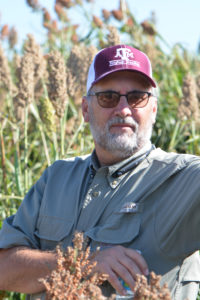Texas A&M AgriLife sorghum breeding program finds new West Texas home
AMARILLO – The longtime tradition of Texas A&M AgriLife having a sorghum breeding program in West Texas will continue, just in a new location, said Bill Rooney, Ph.D., Texas A&M AgriLife Research sorghum breeder, College Station.

Rooney, also the Borlaug-Monsanto Chair for Plant Breeding and International Crop Improvement in the Texas A&M Department of Soil and Crop Sciences, said production issues prompted the movement of select sorghum breeding activities from near Lubbock to Bushland in the Panhandle.
“We will continue to maintain a presence of sorghum improvement in West Texas,” he said. “There’s been at least one sorghum breeder in Chillicothe or Lubbock or West Texas since the early 20th century.”
West Texas is distinctly different from South and Central Texas, Rooney said. And with the sorghum seed industry in the Texas Panhandle, it is important for Texas A&M materials to be characterized for that environment for the seed to be licensed and used there.
“Hybrid seed production is primarily in West Texas, from Lubbock to Dalhart,” he said. “If the parent lines don’t flower at the right time, they will not be useful to commercial seed producers.”
Rooney said the West Texas region, which includes the High Plains, Rolling Plains and South Plains areas, has played a historical role in the development of grain sorghum.
Roy Quinby, who retired about 1960 as director of the AgriLife Research Chillicothe Station, and U.S. Department of Agriculture geneticist Joe Stephens found a sterility system in sorghum, which led to the first commercial-scale production of grain sorghum hybrids in the early 1950s.
Darrell Rosenow, Ph.D., who spent 40 years as the sorghum breeder at the Texas A&M AgriLife Research and Extension Center at Lubbock, led the cooperative sorghum conversion program initiated in 1963 with USDA-ARS in Puerto Rico. This program converted tall, late-maturing exotic sorghums to earlier-maturing lines, which produced well in temperate climates and could be harvested by combines.
Rosenow worked alongside Gary Peterson, Ph.D., AgriLife Research grain sorghum breeder and geneticist who retired last year after almost 30 years in the program.
“For us to maintain a presence of sorghum improvement, we created a research associate position for that area of the state who will be hired soon and will be supervised in part by Dr. Jourdan Bell, AgriLife Extension’s agronomist there in Amarillo, and myself,” he said.
Rooney said the program will continue to work toward tolerance for sugarcane aphids in sorghum in West Texas. Another area of research will focus on the development of specialty hybrids with unique grain characteristics, such as color and waxy endosperm sorghums for improved ethanol fermentation.
“We will also be working with Dr. Bell to continue improvement on forage sorghums that are important to the livestock industry in that area,” he said.
The Bushland Forage Sorghum Plot Tour, where all the forage and sorghum work at Bushland can be viewed, will be Sept. 4.


